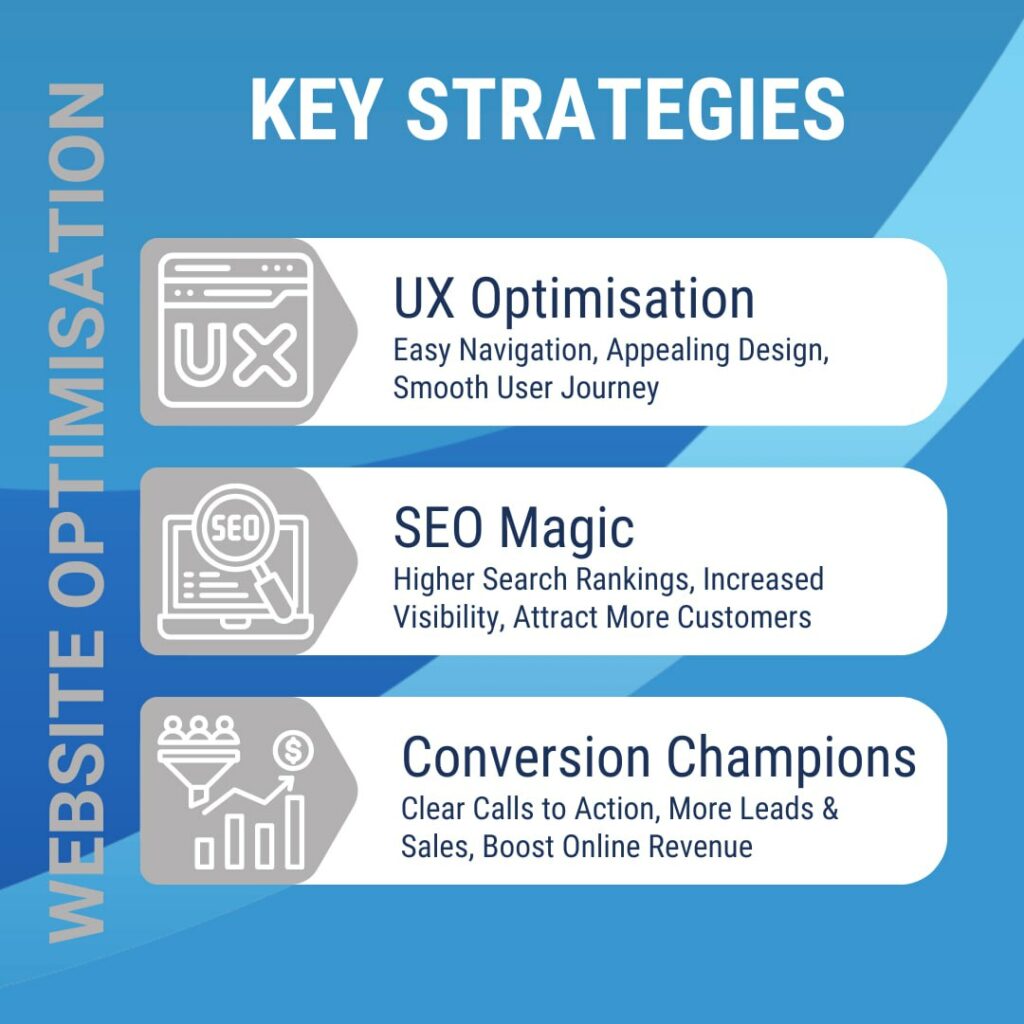We help your Business Appear Where Your Customers Search and Beat Your Competitors to It


Website optimisation involves making changes to your website to improve its performance, user experience, and visibility on search engines like Google.
It includes various strategies such as improving site speed, enhancing user interface, and optimising content for better search engine rankings.
Outdated content, slow loading speeds, and a confusing layout can all lead to frustrated visitors who bounce away or leave negative reviews.
Website optimisation ensures your website is firing on all cylinders, attracting more qualified leads, boosting conversions, and improving your overall return on investment (ROI).
It’s like giving your website a fresh coat of paint and a winning sales pitch – essential for staying ahead in today’s competitive online landscape.
We use a range of data-driven techniques to create a website that works for your business:



While SEO (Search Engine Optimisation) can feel complex, the key principles are clear. Here’s what matters most:
Your website’s content is like a conversation with your customers.
Clear, informative text that speaks directly to their needs is key.
But don’t forget visuals!
High-quality images and videos capture attention, break up text, and make your website more engaging.
This powerful duo keeps visitors interested and coming back for more.
Imagine your website as a well-organised store.
Easy-to-navigate menus, a logical layout, and a clear search function all contribute to a positive user experience.
When visitors can find what they need quickly and easily, they’re more likely to stay engaged and explore further.
This not only improves user satisfaction but also helps search engines understand your website’s structure and content.
Search engines rely on specific signals to understand your website and rank it in search results.
On-page SEO involves optimising elements like page titles, meta descriptions, and header tags with relevant keywords.
Think of these as keywords hidden throughout your website that search engines can “read” to understand your content.
By using relevant keywords naturally, you help search engines connect your website with potential customers actively searching for your products or services.
Website optimisation isn’t magic, but it does require a strategic approach.
Here are four key steps to consider:
By focusing on these core steps, you’ll create a website that’s informative, user-friendly, and search engine friendly, ultimately boosting your online presence.
Website content optimization hinges on creating valuable content that both users and search engines love. Here are some tips:
By following these practices, your website content becomes a magnet for both users and search engines, ultimately driving more qualified traffic to your business.
Website optimisation costs in Australia can vary depending on the size and complexity of your website, the level of work required, and the experience of the agency you choose. Here’s a breakdown with Australian dollar (AUD) figures:
The best approach? Consider your budget and technical expertise.
For a cost-effective starting point, explore DIY options and free tools.
As your needs grow, consider freelance specialists or agencies for a more tailored approach.
Wondering if your website is firing on all SEO cylinders? Here are some telltale signs it might need a tune-up:
If you identify any of these issues, consider running a free website audit tool or consulting with an SEO specialist.
They can provide a detailed analysis of your website’s strengths and weaknesses, along with recommendations for improvement.
Content is the king (or queen!) of SEO. High-quality, informative content that addresses your target audience’s needs is essential for attracting organic traffic and improving search rankings.
Here’s why content reigns supreme:
Investing in high-quality content creation is an investment in your website’s long-term SEO success.
SEO isn’t a magic bullet, it’s a marathon, not a sprint. Generally, it takes 3-6 months to start seeing noticeable results from an SEO campaign, with some taking up to a year for significant improvements.
Here’s why patience is key:
While waiting for SEO results, celebrate the smaller wins like improved website traffic, increased brand awareness, and positive user engagement.
There’s a treasure trove of website optimisation tools available, each with its own strengths. Here are a few popular options to consider:
Remember, the best tools are those that cater to your specific needs and skillset. Explore free trials and research features before committing to a paid tool.